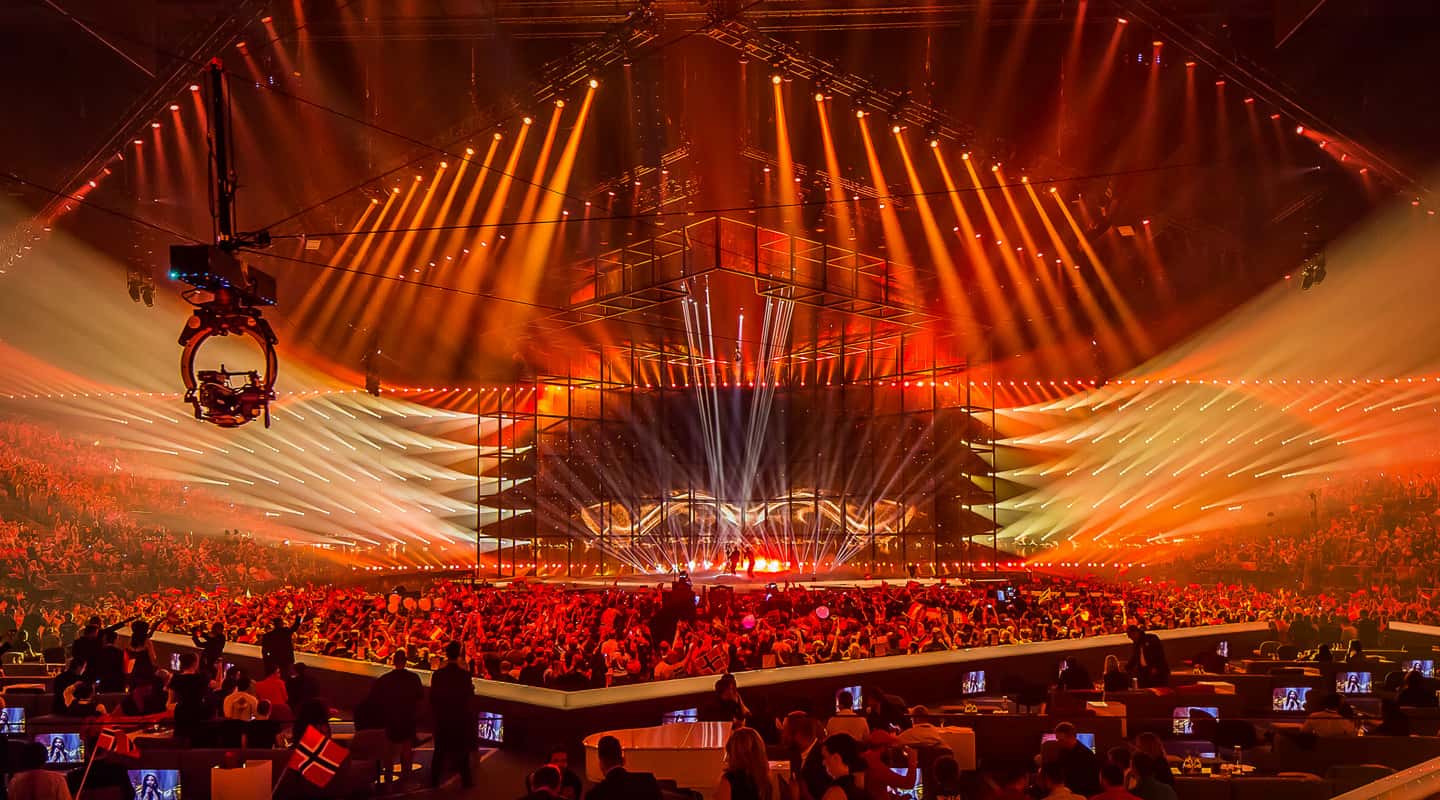
20/20 Eurovision
Every aspect of the AV production for the Eurovision Song Contest 2014 was lavish. Let's take a look at some of it.
Text:/ Andy Ciddor
Let’s get it out of the way right now: the Eurovision Song Contest (ESC) has no artistic merit whatsoever. The songs range in quality from mediocre banality all the way up/down to totally unmemorable. And while they are by no means even the best pop songs from the countries forming the European Broadcasting Union (EBU), this hardly matters, as the contest results are decided by votes from the broadcast audience of around 125 million using a mechanism as representative and transparent as Australia’s senate preference distribution system. Despite (or perhaps because of) this, ESC broadcasts rate their heads off. This in turn has led to a 59-year cycle of one-upmanship between EBU members to stage the most spectacular broadcast ever.
VENUE: COPEN AS BEST THEY CAN
The 2014 Eurovision AV Contest was staged in a former ship-construction hall at the Burmeister & Wain shipyard in Copenhagen, Denmark. The venue was selected for its capacity to hold a vast set, all of the production and broadcast infrastructure, plus an audience of 10,000 on temporary scaffold bleachers. The only major structural work required was to remove a very substantial steel pylon from the centre of the production space. It turns out that pylon was no longer critical to the structure since they’re not hanging parts of ships from the roof anymore, just 272 tonnes of show. Despite the size of the venue, a further 15,886sqm (just under four acres) of Hoeker-style temporary pavilion structures were required to house production offices, crew rooms, dressing rooms, the media centre, etc.
SET: CUBE THE MUSIC
Production designer Claus Zier took his inspiration for the set from a photograph of the prow of a ship under construction in the very hall that the show was being staged in. The set consisted of a hollowed-out cube shape constructed from 124 steel-framed 2.5m high cubes. The cube walls enclose the two upstage edges of a 156sqm diamond-shaped LED stage floor that was bordered by a water-filled moat on the two downstage edges. The understage area, which continued under the moat gave full access for crews to set and strike pyros, flames, atmospherics, electrics, props and even TV cameras through stage traps and portals in the moat. A section of cubes in each of the set walls was hinged to swing open as double-doors onto the stage to enable the extremely fast scenery and talent turnarounds required for this very tight live-to-air production. To expedite turnarounds all stage markings for sets and talent were programmed into scene-change images in the LED floor, much neater, and cooler, than 40-odd sets of coloured tape marks. Behind the cube set was a monolithic 114m wide by 12m high video backdrop.
Although the cube set looked very clean, sparse and uniform, 10 of the cubes actually included transparent polycarbonate decks for talent to work on. Polycarbonate panels backed with self-adhesive Smart Tint film were fitted to the on-stage faces of the 70 of the most-central cubes. The smart Smart Tint film in its rest state is effectively transparent, but when energised it becomes sufficiently translucent to provide a projection surface. Whilst the film is not a perfect projection material, some judicious adjustment of projection positions and shot angles eliminated any projector hot spots from showing on air. The frame of each cube was outlined with custom-configured, pixel-addressable Martin VC-25 RGB LED stripping. The 5500 LED strips were driven by 16 of Martin’s P3-200 video system controllers that received their video input from the d3 media server network.
Nothing Exceeds Like Excess: Thousands of beams through cubic kilometres of haze, disappearing projection surfaces, an interactive LED floor, 1700sqm of LED backdrop, flying cameras, and enough audience lighting to cover the main stage for a half a dozen live concerts. Imagine what it would have been like if they’d had a big budget. Photographer: [email protected]

LIGHTING: 3000 FIXTURES
To avoid mid-air collisions with the two wire-suspended Spidercam rigs operating over the stage area, no trusses could be flown below 30m during broadcasts, which clearly had a major impact on the selection of overhead fixtures. For this show, the new generation of ultra-narrow fixtures became the only game in town.
The nearly-3000 fixtures used in the production were provided by Danish production house [Lite]com, with quite a bit of help from PRG, who not only supplied 144 of its own Bad Boy fixtures for the rig, but also provided a further 800 fixtures, a couple of kilometres of truss and 150 of the production’s 650 chain motors. The mix of equipment included quite a bit of gear from the until-recently-Danish Martin, but also many luminaires from Clay Paky, SGM, GLP, Vari-Lite, Showtec and four LED Source fours from ETC. Of course the followspots were Robert Juliat’s Cyrano and Aramis.
It would come as no surprise in 2014 to learn that the control system comprised 7 x grandMA2 full-size and 2 x grandMA2 lite consoles driving 19 x NPUs (Network Processing Units) with show pre-visualisation and blind editing running on MA 3D. The MA Ethernet network was based around 17 x Luminex GigaCore switches to provide four independent dual-fibre rings.
ACOUSTICS: DOWN TO 1Hz
Terrified of repeating the acoustic disaster that was the previous ESC staged in Denmark in 2001, great care was taken with treating the acoustics of the cavernous concrete and steel structure of the B&W Hallerne. Starting with a reverberation time of 13.2 seconds in the untreated space, the acoustics team got the reverb time down to an intelligible 4s through the application of 60,000sqm of traditional black Molton cotton cloth in three and four layers around the walls to take care of the high-to-mid frequencies. The more troublesome low-frequency reverb was treated with a host of huge black cylindrical balloons (constructed like big air mattresses) suspended high in the roof space of the venue. Only recently developed by Denmark’s Flex Acoustics, the AqTubes are designed to absorb frequencies in the pesky 1Hz – 63Hz range.
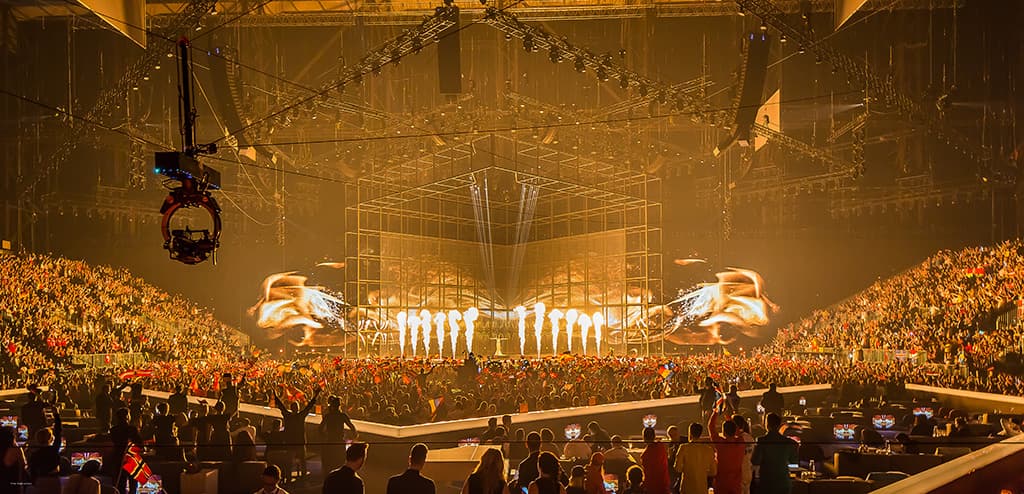
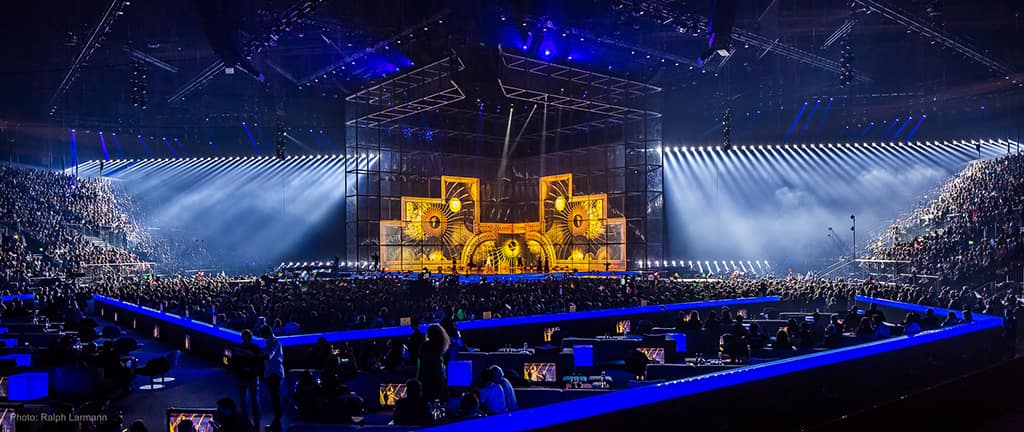
AUDIO: 786×256 MADI MATRIX
While the audience is actually only present to provide shoot-off and foreground for the camera shots and applause effects for audio, it is however folly to treat them with disdain and provide them with inadequate, unintelligible or badly lip-synched PA, so they must be provided with a concert-quality PA that doesn’t impinge on the 5.1 broadcast sound. Audio contractor MOTO Rental engaged Rent-All to provide the PA system which was an all L-Acoustics affair using K1, K1-SB, K2, Kara, SB-18 cabinets, powered by L-Acoustics power amps driven by Dolby LM44 controllers.
With the huge range of audio sources and different mixes required for PA, monitors and broadcast, this production was the first to use five of RME’s new MADI routers to create a 768 x 256 routing matrix to link the two Digico SD7s, the Digico SD10 and the two Midas XL8s used for monitors as well as routing outputs to the PA.
Not only was the B&W Hallern an acoustic nightmare but the venue also turned out to be more than a little problematic for wireless signals. With 22 television channels already operating in the area and a building full of media and international broadcasters, spectrum allocation for 96 channels of Sennheiser radio mics and the 28 channels of wireless monitoring was never going to be easy. However, the propagation characteristics of the steel-shelled building with its surprisingly-reflective, heavily-reinforced concrete floor and metal corners of the building that acted as additive in-phase signal boosters, produced a range of multi-path problems that required a great deal of experimentation with antenna placement and every bit of available receiver DSP power to process the incoming RF to extract the right signal.
MEDIA SERVERS: HI VIZ
Audiovisual provider, Mediatec Solutions Sweden (the parent company of Mediatec in Australia) partnered with d3 Technologies to provide the video servers to pre-visualise, store, replay, map, process and distribute the production video content. The content production houses building the layers of content for the 40-plus acts (mostly in Adobe After Effects or Maxon Cinema 4D) were each provided with a d3 licence and a set of production templates to allow them to fully pre-visualise their material before shipping it to Mediatec in Denmark for ingestion and processing. One production house went so far as to provide a fully-sequenced d3 track ready to load and run.
The server system consisted of a master d3 4U server (and its redundant backup/understudy) at the control position in FOH, and four slave d3 4U servers (each with its redundant backup/understudy) in the backstage production area. Each slave server had a dedicated application, one each being allocated to feed the cube LEDs, the LED backdrop, the cube projectors and the interactive LED floor. All of the slave machines fed their video outputs into a 32 × 32 Lightware matrix switcher, which then distributed video to the various display devices via fibre.
PROJECTION: STACKS ON
Although the rise to prominence of the display panel and the LED module has taken some of the shine off big venue concert projection, there are still some image display tasks that just can’t be handled any other way. Projection on to the 70 translucent cubes in the set required some serious grunt to balance against the stage light levels and overcome the low optical gain of the Smart Tint film. Video supplier Mediatec pulled out the big guns for a head-on brute force attack, using 16 x Barco HDQ-2K40 (double stacked in portrait) for the 55m throw to the upper rows of the cube and 16 x Barco HDX-W20 (double-stacked below stage) for the 4m throw to the bottom rows of the cube.
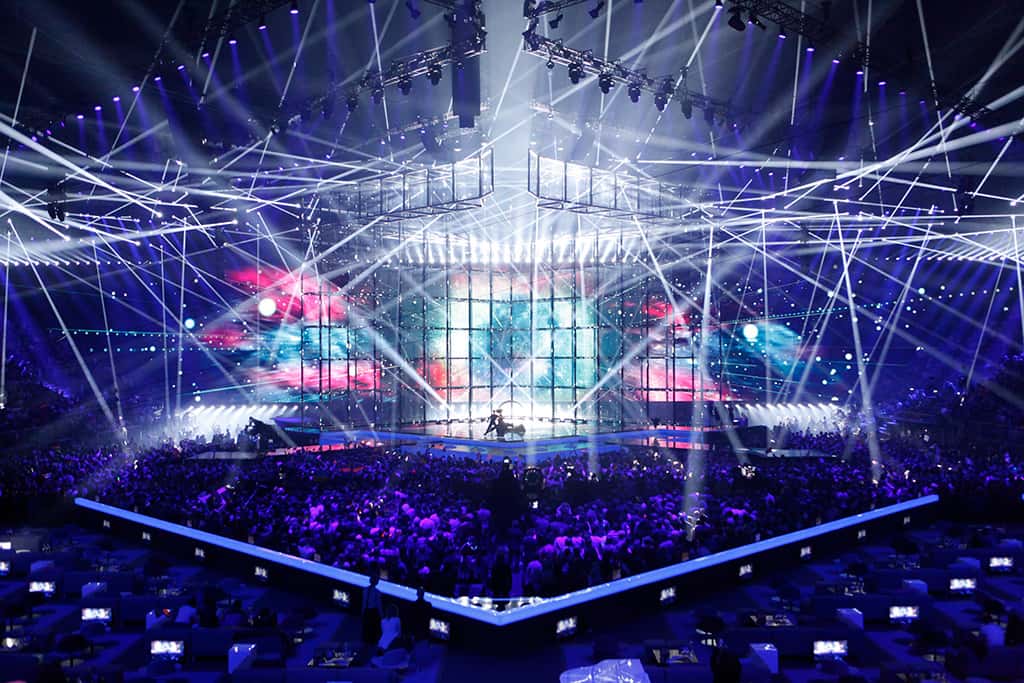
LED PANELS: TOUCH SENSITIVE
The impressive LED backdrop was constructed from 1170 of Kindwin’s Spider F-30 open-strip panels. Each 960mm x 960mm, 30mm-pitch panel consumes around 300W to drive its 32 x 32 pixel display, which comes to about 350kW for the backdrop.
Used for the first time on Eurovision, the interactive stage floor was constructed from Mediatec’s new touch-sensitive tecViz BS10 480mm x 480mm LED floor tiles. The 10mm pitch, 12-bit, 48 x 48-pixel tiles have a surface of smoked-black, scratch-resistant, 8mm safety glass which can support a load of about 250kg. Weight sensors in the corners of each tile divide it into four sensing zones, and in combination with d3 media servers, the tiles provide live tracking of movement on their surface.
“We did encounter some challenges as this is a brand new product to the market place,” explains Casey Bennett, Mediatec’s production manager for video. “During the initial load-in, the venue was at 6°C, but as the weeks went on, heating was installed (especially in and around the stage) and temperatures under the stage were topping 40°C. This gave us some serious heat-related problems, so we installed an extensive ventilation system to counteract this issue.”
CAMERAS: DOES WHATEVER A SPIDER CAN
Camera coverage on the ESC broadcasts is another technology arms race that appears to gain momentum every year, with all kinds of gimmicks and doo-dads being tried on the production. If you cast your mind back to 2009, you may recall the Steadicam operator who came roaring down the auditorium aisle on a Segway, stepped off it, walked up a ramp on to the stage then circled the talent, on-air the whole way, on a single shot. In the tradition of ESC, it was simultaneously impressive and pointless. Whilst ESC 2014 eschewed the use of a Segway, among its 22 cameras there were two wire-suspended Spidercams for the first time. A simple 2D Spidercam was used to track across the stage at variable heights, eliminating the need for some of the more outrageous camera cranes that have been used for the broadcast. The 3D Spidercam enabled shots from floor level to above set height over the entire set and much of the auditorium, providing a vast range of shot possibilities, and thankfully it wasn’t always used for moving shots. Just because a camera (or moving light) can move doesn’t mean that it has to move.
Coordinating the movements of the two Spidercams to avoid entanglements and collisions took a lot careful choreography and planning which was aided by the use of a brand new piece of Danish technology, CuePilot software. CuePilot enables complex and accurate shot pre-plotting, allocation and automation for complex multi-camera broadcasts. Camera shots are allocated on a timecode-synched timeline like a non-linear editor, and can be pre-plotted and rehearsed with rehearsal tapes or stand-in rehearsals, then used to give camera stand-bys and execute precise source switching on air. What this brought to the ESC broadcast was a camera plot so well planned and rehearsed that there were virtually no cameras caught in shot during the broadcast. When was the last time you saw that on a production with fly-cams and especially Steadicams?
Once again the 2014 Eurovision Song Contest show was a glorious victory of technology-driven spectacle over content. But that’s what you expected me to say.
MORE INFORMATION:
CuePilot: cuepilot.com
d3 Technologies: www.d3technologies.com
Flex Acoustics: flexac.com
MediaTec Group: www.mediatecgroup.com
Spidercam: www.spidercam.org/en


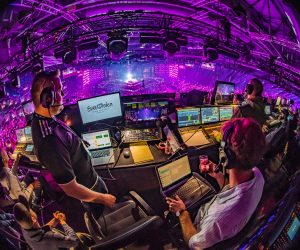





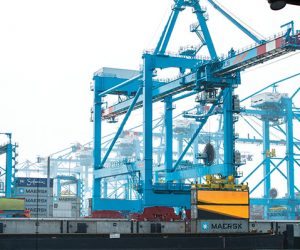



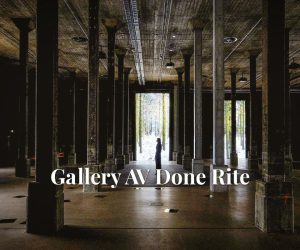


RESPONSES